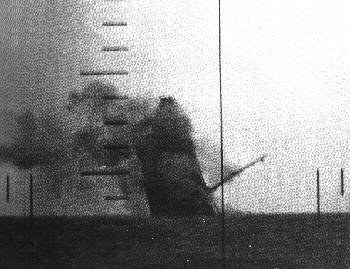“Japanese overconfidence, under estimation of the enemy and overextended supply lines which could not be protected were basic causes. After that I would say the reasons for their disaster could be classified as follows in order of importance: first and by far the worst were the attacks of the highly efficient American submarines on merchant shipping…”
German Vice Admiral Wenecher
On reasons for Japan’s devastating loss.[1]
“The greatest mistake Japan made in the war was in not attacking the United States submarines.”
Ito Itaki
Japanese High Command recorder[2]

Figure 25. Another victim of Wahoo.
Introduction
World War II in the Pacific Theater of Operations relied on the United States Navy in almost all aspects of the war. Command of this large ocean theater was split primarily into ADM Nimitz’s Central Pacific and GEN Macarthur’s South West Pacific AORs (Areas of Responsibility). Due to President Roosevelt’s concurrence with Prime Minister Churchill on the Atlantic Charter, the war against Japan became a secondary issue. The 1940 “Two Ocean Navy” Act provided a navy thought to be large enough to fight both in the Atlantic and Pacific. This force prior to Japan’s attack was divided into an Asiatic Fleet and Pacific Fleet. Between the surprise attack on Pearl Harbor and the Battle of Java Sea, the IJN (Imperial Japanese Navy) decimated the United States Navy. The remnants afloat were either aircraft carriers, requiring a relatively major surface ship escort[3], and submarines.
Following the losses in 1941 and 1942[4], United States Naval offensive capability remained solely in the hands of the submarine force. This left the large portion of winning the war against Japan in the lap of the submarine forces of the Asiatic Fleet, Pacific Fleet, and eventually forces belonging to Commander, Submarines, South West Pacific. Though a struggle, these submarine forces carried the war to Japan’s very doorstep.
A proper understanding of the operations of United Stats Navy submarine forces against Japan needs an explanation of the development of the submarine force. This includes a working knowledge of the development of United States Navy submarines, the submariners, the development of technology including the primary weapon of submarines – the torpedo, and the conduct of the war.
%20At%20Pearl%20Harbor,%20soon%20after%20the%20end%20of%20her%20third%20war%20patrol,%20circa%207%20February%201943..jpg)
Figure 26. Crew of USS Wahoo following a Clean Sweep circa 1943.
[1] Merrigan, Don “World War II Silent Service” Subnet.com (www.subnet.com http://www.subnet.com/caU.S.s/wwii.htm) 23 January 2005.
[2] Ibid.
[3] Offensive operations by the carriers during the war relied on the availability of conventional naval forces. Too many of these either sat the mud of Pearl Harbor or were fighting the Battle of the Atlantic.
[4] 1942 was a very rough year for the carriers. CV-1 Langley, now converted to an AV carrying Army Air Corps P-40 fighters, was sunk in the Java Sea 27 Feb 1942. CV-2, Lexington, was sunk in the Battle of Coral Sea on 8 May 1942. CV-5, Yorktown, was sunk by IJN torpedoes at the Battle of Midway on 7 June 1942. CV-7, Wasp, and CV-8, Hornet, were sunk in naval battles supporting the Guadalcanal campaign (15 Sep and 26 Oct 1942 respectively). CV-3, Saratoga, was torpedoed but not sunk on 25 August 1942 also in support of Guadalcanal. CV-4, Ranger, was thought to be “too small” for the Pacific (even though much smaller CVLs (light carriers) and CVEs (escort carriers) operated in the Pacific later) and was kept in the Atlantic. Following Hornet’s demise, CV-6, Enterprise, was the only carrier ready and able to carry the war to Japan till Saratoga and Essex, CV-9, could join the fleet in December 1942.